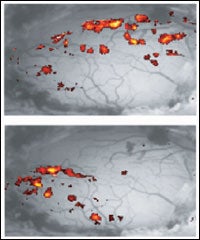Researchers Find That “One Sniff Will Do” For Odor Discrimination
Cold Spring Harbor, NY — Rats inhabit a world of smells far beyond our poor powers to discriminate. Thousands of odors that smell the same to us, or that we cannot perceive at all, are quickly recognizable as distinct and meaningful odors to rodents and other animals in which the Nose Knows. But just how quick?
By measuring the speed of smell, researchers at Cold Spring Harbor Laboratory have now found that unlike humans, rats can tell two very similar odors apart with just one sniff. And because it’s not the Nose that Knows, but rather the brain, such studies of how animals can rapidly and accurately discriminate odors are revealing vital new information about how the human brain processes information, guides behavior, and even enables us to be consciously aware of our own (though less smelly) world, and our own selves.
“We are trying to understand how systems of neurons participate in the creation of perception, awareness, and behavior,” says Cold Spring Harbor Laboratory neuroscientist Zach Mainen, who led the new study.

By exploring the neural mechanisms by which rodents use odors to guide their behavior, Mainen and his colleagues hope to uncover basic principles of brain function that will apply in many settings, including how our own brains work. But to get there, they needed to start out by measuring seemingly strange things such as how many sniffs a rat takes per second. The answer, according to the new study: about eight sniffs per second.
Believe it or not, the “eight sniffs per second” measurement has helped resolve a hotly debated issue in neuroscience. Researchers have previously suggested that the brain requires extra time to distinguish among the millions of different chemical signals that can be picked up by the nose. The new study, which appears in the November issue of Nature Neuroscience (advance online publication date: October 20), overturns this conventional wisdom that smell is a slow sense.
“We found that a rat gets a complete sense of an odor with each sniff. The speed of olfactory perception appears to be limited by the speed of the breathing cycle rather than by processing speed in the brain. For humans breathing is relatively slow, but because rats sniff quite quickly, smell is a fast sense for them,” says Mainen. “Rats probably use a series of quick olfactory snapshots to solve complex problems like tracking the source of an odor.”
Humans are far more attuned to the visual world, but the computations our brains carry out are not all that different than in rodents. According to Mainen, the neural mechanisms that enable rodents to identify an odor in a single sniff may be similar to those that help us take in an entire visual scene in a single glance.
Mainen and his colleagues are currently recording electrical signals from neurons in the brains of rats as they perform the odor discrimination task (see figures). In this way, the researchers hope to learn more about information processing in the olfactory system, and to explore the neural basis of perception, motivation, decision-making, and other aspects of behavior.
Written by: Communications Department | publicaffairs@cshl.edu | 516-367-8455